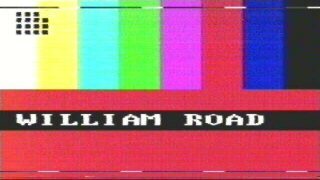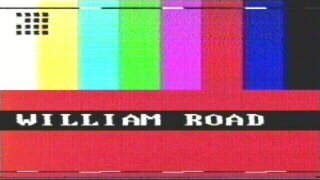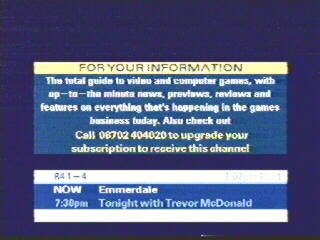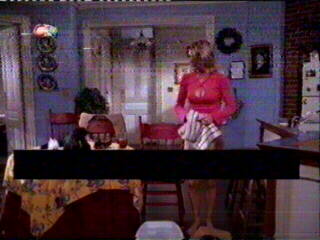This page last updated on Friday, October 13, 2006 at 9:45:36 AM
| Home | | ATV | | ATV Centre | | Schools | | Fenton Relay | | Antenna Theory | | Other Pages |
ITV1 Tests on Digital Satellite (DSAT)
After a brief spell of testing on the morning of 26th October 2001, ITV1 resumed tests on the Astra satellite at around 6pm on Halloween.
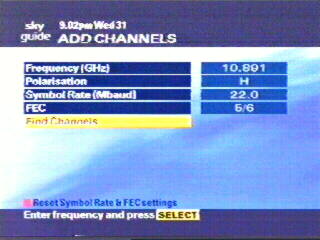
|
The tests aren't accessible by typing in the channel number. They have to be added manually, by supplying the frequency, polarisation, symbol rate and FEC (forward error correction). You can find these tests by doing the following:
|
|
After the frequency, polarisation, symbol rate and FEC have been supplied the digibox looks for any channels on the transponder (a transponder is a bit like a channel on analogue TV) and lists those that it found. There are eight channels on this multiplex (a multiplex, or MUX, is a collection of digitally compressed stations on a transponder). On this transponder only 2-1 to 2-7 are used, 2-8 was blank at the time. |
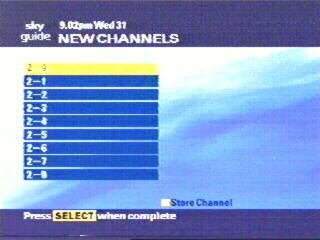
|
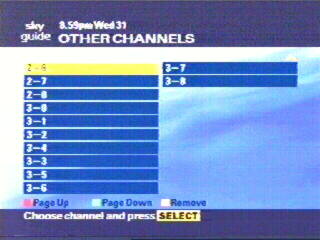
|
Once added, the 'Other Channels' menu must be selected from the 'Services' menu. They're certainly hidden away, these tests! |
|
Following are the test transmissions available with this equipment on Wednesday 31st October. One transponder's channels were not available, presumably due to technical problems at Astra's end. The pictures' labels refer to the channel ID given to them by ITV or Astra (this is not the final name for the channel, or course) and what ITV1 channel will be broadcast on that channel. The channel IDs were amended during the day on the 1st November from, for example, '2-1' to 'R2 2-1'. The 'R' denotes the region number. |
 R2 2-1 : Anglia |
 R9 2-2 : Border (England) |
The tests caused this TV to switch to widescreen 16:9 mode, and this is the format they're presented in here. |
|
The ITV network is split into 14 regions, and some of these have sub-regions, for example Carlton Central West, South and East. There looks as though there will be two sub-regions of Border being broadcast - all others apart from HTV have one sub-region only. |
 R14 2-3 : Border (Scotland) |
 R7 2-4 : Granada |
Although at first glance these tests all look the same, each has a different block missing in the 16 dark squares in the top left of the screen. The top, left corner is block 1 (which corresponds to region 1) and they increase left-to-right, top-to-bottom. If you count the position of the missing block on this slide, it can be seen that it is position 7, which corresponds to the region number given on the channel ID. |
|
"William Road" apparently is an NTL switching centre. |
 R5 2-5 : Meridian |
 R10 2-6 : Tyne Tees |
Digital television will sometimes freeze when there is a technical problem, so a mechanism is required to show that everything is still working. The white dashes at the top and bottom move from left to right to show that the video hasn't frozen. |
|
The audio accompanying all of the tests is a tone (1kHz?) which alternates as follows: left channel only, both channels, right channel only, both channels and then cycles again indefinitely. The tone is similar to the BBC's GLITS tones used for testing stereo sound. |
 R8 2-7 : Yorkshire |
 |
This is channel 2-8, on the same transponder as the above. Nothing is being transmitted, hence the blue screen. |
|
The tests are grouped together by parent company (if applicable). On the transponder at 10.832 GHz are Carlton's channels (1-1 to 1-5), Granada's are on 10.891 GHz (2-1 to 2-7) and SMG/Independent channels are on 10.906 GHz. |
 |
 |
A DSAT transponder can hold, at a push, eight TV channels. The '3' multiplex has only four channels on it. |
|
Multiplexes can divide the bandwidth ('space') on a transponder statically or dynamically. An example of a static set-up would be if there were eight channels on a multiplex and they all had a eighth of the available bandwidth each. If the multiplex's space is allocated dynamically, this is known as 'statistical multiplexing.' |
02/11/01 - I suspect this one's been labelled wrongly - it should be R15, as Meridian is already region 5. |
 |
Statistical multiplexing analyses how much bandwidth is required to transmit the pictures and sound. Static or slow-moving images like this don't need much space to be transmitted - they use a low amount of bandwidth. Fast-moving signals need more space to be transmitted and need larger amounts of bandwidth. Statistical multiplexing allocates bandwidth to each channel in the multiplex depending on how much bandwidth the channel needs at any instant in order to be transmitted satisfactorily. If one channel needs less bandwidth than another channel on the same multiplex then more bandwidth can be given to the channel in need. Statistical multiplexing can result in more bandwidth being available to transmit a given number of channels on a multiplex, and hence better picture/sound quality. However, more often than not, it is used to squeeze more channels into a multiplex rather than to improve picture quality for the viewer. It is not known yet whether ITV1 will use static or dynamic multiplexing. |
|
During the afternoon of the 1st, the first multiplex was operational. The William Road test pattern was transmitted for a short time on the channels within this multplex. |
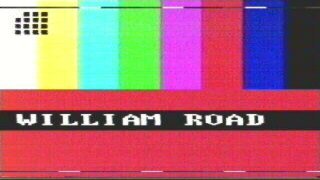 R1 1-1 : Carlton / LWT |
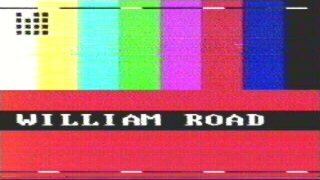 R3 1-2 : Central West |
During the first day of testing the search-and-scan banner was displaying programme names and times, correct for each region. This feature was patchy over the first couple of days. |
|
A list of regions in region number order: 1 - London (Carlton / LWT) They don't seem to be in any particular order, other than London being first! |
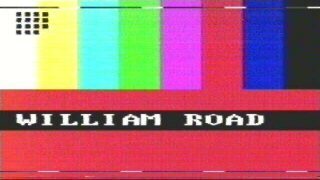 R16 1-3 : HTV Wales |
|
|
|
|
On the weekend of 2nd/3rd/4th November, only Anglia's channel displayed the colour bars. The others had a blue screen, an example pictured right. The "For Your Information" banner didn't carry the correct information for ITV - the information it contained was the information stored in the "All Channels" section of the Digibox menu. If, in the "Other Channels" menu, the ITV channel was the 10th in the list, you'd see the channel information for the 10th channel in the "All Channels" list. This could well be testing the soft-encryption, so that ITV is not available abroad, or conditional access, where viewers only recieve their local ITV region by postcode. |
|
 |
By 8.15am, 5th November - the William Road colour bars returned on all channels. By 11.30am - NTL were testing broadcast ITV programmes on all channels except for Scottish, Ulster and Channel. By 12.30am - All channels were testing live ITV. This is a still from HTV Wales, showing the search-and-scan banner. Widescreen switching was not working at the time of capture, so Vanessa Mae looks a bit squashed! |
|
A Granada ident, recorded outside of Granada's terrestrial coverage area. |
 |
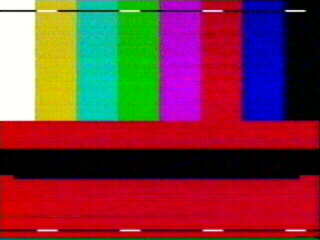 ITV2 0840, 13th November 2001 |
On the 12th, the channel labelled '3-5' began broadcasting EPG data (ie. now and next information) . The next day, the colour bars (left) were shown - static (the white bars that usually moved were stationary) and with no William Road legend. Now and next info on the EPG was working. Two days later it was discovered that Anglia's website said that Anglia would be available on DSAT from the 20th. |
|
Later on that day William Road colour bars were back, and in motion. |
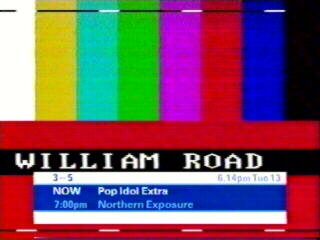 |
|
|
On the 16th, at 0850, this static image from CITV was broadcast. Note the black bar, which is where it would normally say "William Road". |
|
On the morning of the 19th November, the channel labels changed to reflect the names of the ITV regions, and the black matrix at the top left of each channel disappeared. |
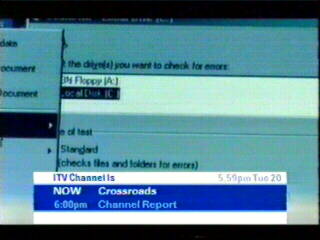 |
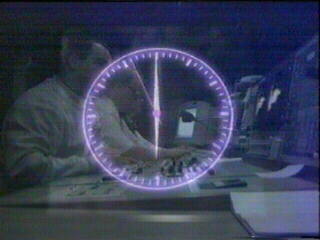 Channel TV's 6 o'clock station clock, before the regional news bulletin Channel Report. Looks similar to the 1970s ITV Schools countdown clock! |
At about 1730 on the 21st, a day later than was reported on Anglia's site, ITV1 quietly began on DSAT proper on channel 103 - previously a banner appeared saying "Press TV and 3 for ITV". The viewer's local ITV station, calculated by postcode, was on 103 and any other ITV regions receivable at that postcode were at 963 and 964. Widescreen switching was not working on most channels. ITV2 appeared on DSAT channel 226 the following day. As of the time of writing, all 16 ITV1 regions broadcast on DSat are still visible - let's hope it remains that way for those with an interest in presentation! |


